Before I resume the narrative from last time, I’d like to draw people’s attention to the comment I’ve added to the Fragments on Aperion post. This seems to be easily the post so far that readers are finding the most interesting and thought-provoking, and a few have discussed it with me. However, they’re doing it in person or on social media, rather than here. I do recognize that, for those who know me personally, sometimes there’s no substitute for face-to-face discussion. But on the whole I’d rather have such comments here if at all possible. Though I do still view this site as being in a “soft-launch” phase, the more interesting it is when I’m ready to seriously start promoting it, the better, and I think having more than one voice could be a big part of that.
The same is, of course, true of any other post on this site that you find interesting or have a question about, including this one. If you’ve got something to say, I’d like to hear you say it. Even, and maybe especially, if you feel like you’re not that knowledgeable about RPGs.
I’d like to start this post in earnest with an observation on the previous one. One point I made last time is that I’d been skeptical of the storytelling potential of videogames until my first encounter with the game we now know as Final Fantasy IV. My sense of things at the time, as far as I can reconstruct it now, was that games had a very limited set of tools for storytelling. Which, at the time, was true as far as it went; my error lay mostly in overestimating its relevance.
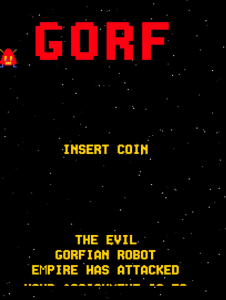
GORF in attract mode, with the titular “boss” hopping onto the screen on the left as its Star Wars-inspired crawl begins. (Important note: “Gorf” is “Frog” spelled backwards.)
In 1991, today’s photorealistic 3D models and extensive voice casts were still a twinkle in various eyes. It wasn’t so long ago that the arcade game GORF had been considered innovative for having a crackling, electronic voice taunt the player occasionally – “Tooo baaaad, spaaaaace caaaaaaadet”, the game would say to you after blowing up your spaceship, somehow managing to roll the R in “cadet” despite the fact that there isn’t one. While primitive by today’s standards, this was a Big Deal at the time, requiring extra hardware that didn’t come in a standard arcade cabinet. Among other things, this meant you could forget about getting anything comparable on a home system. Ten years after GORF, sound cards capable of doing convincing speech were still more expensive than an entire SNES system (and in my experience, it was a total crapshoot whether they’d actually work as advertised on any given computer).
This limited the storytelling options of most videogames of this era to, roughly, the set of tools available in silent movies. Dialogue boxes are obviously analogous to title cards. Both tended to have music running throughout, an especially important similarity in the Final Fantasy series given Nobuo Uematsu’s impressive compositional skills. Beyond this, both were confined to what could be conveyed visually with a tool set that looks primitive today, though of course the particulars were significantly different.
And though it seems silly and narrow-minded now, at that age I really don’t think I’d have given a silent movie a fair shot either. How many 18-year-olds would? (It wasn’t to be long before that changed, but that was thanks to a film studies class; if not for that class, I seriously doubt I’d have ever watched such a movie of my own volition until much more recently, perhaps this one.)
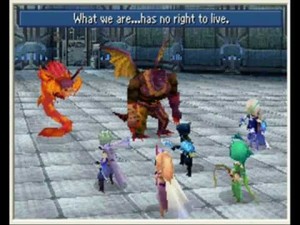
FFIV showed a new generation (well, me, at least) how a limited set of storytelling tools could still be effective.(Screenshot is from the much more recent DS remake.)
If anything, silent films had one huge advantage that early 90s videogames did not – human actors. True, Square did have some tools in 1990 that silent film directors in 1920 did not. (Square being the then tiny-for-a-videogame-developer company that made the early Final Fantasy games. It has since grown, or perhaps metastasized, into the “Square” in the Square-Enix juggernaut. Old school gamers like me will sometimes say “SquareSoft” when talking about this era, as I did in an earlier version of this post, but properly speaking that was just their English-language publishing arm.) They had sound effects and colour, and their visual effects weren’t limited by what you could build easily with pre-WWII technology. But given the limitations of early 90s sound and graphics, these advantages didn’t amount to much. Even more than the makers of silent films, then, most of Squaresoft’s storytelling had to be accomplished by flashing words across a screen; words your audience was going to want as succinct as possible.
To my teenaged self, that seemed like a cripplingly limited set of options, but like the silent film directors decades earlier (and to this day), Hironobu Sakaguchi and his team found ways to make them work. I don’t know if they consciously looked to silent films for techniques – indeed, I don’t know of anyone who has even drawn this parallel prior to myself, whether or not they worked for Square. It’s an interesting analogy that I don’t feel like I have the tools (particularly the knowledge of silent film) to pursue as much as it deserves to be pursued. Now I feel like I should do some research, then compare the two sets of storytelling techniques in more detail in a future entry.
My next major contact with the Final Fantasy series must have taken place in 1994. I was, again, at my cousin’s place, where I noticed what a quick Google search tells me must have been issue 66 of Nintendo Power sitting open on the table. This issue contained a 12-page preview of the game North Americans would initially know as Final Fantasy III (Final Fantasy VI in the original Japanese numbering, of which I was, at this time, still ignorant). And the way it was illustrated was like nothing I’d ever seen before.
If you are asked “who is the first person you think of when you think of Final Fantasy” and are among the tiny percentage of the population who are big enough Final Fantasy nerds to have an answer, and furthermore are fairly old-school like me, there are basically three likely responses. Hironobu Sakaguchi wrote/designed the original Final Fantasy about as close to single-handedly as it’s possible to do such a thing, then served as the director (which means about the same thing in videogame development as in filmmaking) for Final Fantasy II through V (Japanese numbering), came up with the story for Final Fantasy VI and VII… but I’m getting ahead of myself. Nobuo Uematsu is the composer of some of the most striking, emotionally resonant music ever featured in a videogame series. The third member of the triumvirate is concept artist Yoshitaka Amano.
Whereas the previous North American Final Fantasy releases had shied away from including Amano’s artwork, already prominent in the Japanese releases, this preview – and the actual game manual, once it came out – featured it prominently. And it was dramatically improved over what had appeared with the original Final Fantasy. Stylized yet extremely detailed figures peeked around screenshots; strange creatures and even stranger people lurked between paragraphs. Most of the playable characters seemed to have tamed some creature from no sane imagination as mounts (I was disappointed that none of these made it into the actual game). Though I knew (and still know) little of art history, it was obvious enough that there were a variety of influences here, from traditional Japanese woodcuts to experimentally-minded early 20th century illustrators, but that Amano had turned them into something uniquely his own. My favorite comic-book artist at the time was Bill Sienkiewicz (though apparently, I’m not enough of a student of his work to have had a hope of spelling his name right without Google). In Amano, I perceived a different branch of the same, or at least a similar, tree, in that both had pulled together a wide variety of progenitors, some of which they possibly had in common, into something you’d never mistake for anyone else.
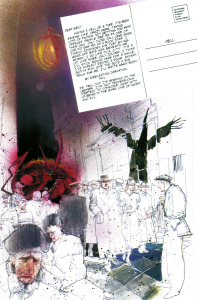
Like Amano, you’re not likely to mistake Bill Sienkiewicz’ work for anyone else’s. (Example page from Stray Toasters #1.)
Both artists had also pulled what I call a Dark Side of the Moon, a feat named, of course, for the famous Pink Floyd album. Much of the genius of that album lies in the fact that it took a very unorthodox, avant-garde set of influences and managed to combine them into something that was not only brilliant in its own right, but sufficiently accessible to reach a mass audience, becoming one of the best-selling records of all time and arguably the most enduringly popular. I felt like both Amano and Sienkiewicz had tapped some of that magic of producing something that was at the same time widely accessible and clearly artistically serious. Like Square with Final Fantasy itself. Like I, for a few moments here and there on my best, most confident days, dare to hope I’m able to do with Fantasy Infinity.
In any case, seeing Amano’s artwork in that article made me realize that here was a company that, while still producing something enjoyable and accessible, also took videogames seriously as an art form. I suppose I sort of understood that with the previous release, but now I was convinced that it wasn’t a one-off but a recurring pattern.
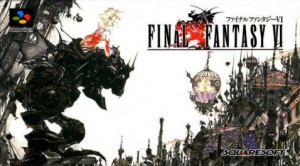
This time around, I wish they had used the original Japanese cover (though at least this artwork could be seen inside the manual).
So eventually the game itself came out. It was a bit of a slow starter, and again the translation didn’t do it any favours, though it was noticeably better than the previous two North American releases. This time, translation duties were handled by a native English speaker, one Ted Woolsey, and the most commonly-cited flaw in Woolsey’s work is that he could be creative to a fault, sometimes seeming more interested in telling his own story than in presenting the one Sakaguchi and company had written. But it does have some other issues. He seems to lose track of details sometimes, particularly as they pertain to character motivations, so for example, characters with no obvious reason to lie tell you three conflicting things about the relationship between Narshe and the Empire in the first few scenes. He also has a tendency to miss the point of the game’s literary, mythological, and pop-cultural references, and thus makes a hash of some of them (a simple example from early in the game being translating a name as “Vicks” instead of the intended, Star Wars-referencing, “Biggs”). More recent re-releases are much better-translated in these respects.
Despite miscommunicating a few minor things, though, it becomes apparent very quickly that this is a work of at least equal depth to its predecessor, mostly via the hook of Terra’s mysterious background and powers. It’s clear there’s something of mythic weight going on there, though at the start of the game you have no idea of its specifics. At the same time, the distinctly Japanese quirkiness is certainly still there as well. I think I was sold when, about half an hour in, the three playable characters at that point make their escape from Castle Figaro by leaping onto the backs of waiting chocobos in an obvious nod to spaghetti-western cliches, said castle then sinking beneath the desert sands under its own power. Here was a wonderful mix of the familiar and the completely loopy that I’ve been trying to capture in my own work ever since (and that most American developers seem to take themselves way too seriously to touch, though you do see some of it in the amazing Divinity: Original Sin series).
Also, about halfway through, you might want to be prepared to be punched in the stomach.
Now, here the Final Fantasy hipsterism I mentioned at the outset may be showing. People writing pieces like this often talk about Aeris’ death, a key plot twist in the series’ next major entry, as a turning point in how they experienced videogame storytelling. (This doesn’t really count as a spoiler. If you know one thing about the plot of one Final Fantasy game, it’s probably that Aeris dies at the end of disc one of Final Fantasy VII. Even if you have no idea who Aeris is. This is a spoiler like “Rosebud is his sled” or “Norman’s mother is dead” or “The Phantom Menace sucks”.) But to me, that has nothing on what happens at the midpoint of Final Fantasy VI.
At this point in the game, you fail to prevent a madman from triggering the magical equivalent of a nuclear war. That’s not the punch in the stomach – I’m still setting up here. Though it must be said that, unlike many games with similar stakes, Square actually thought to populate this world with people you care about, not all of them playable characters, so it does have some power in its own right.
(Incidentally, at least one post the size of this one could be spent just on the topic of metaphors for the bomb in Final Fantasy. And being just enough older than most of my intended audience to vividly remember the Cold War, I know a bomb metaphor when I see it. The Japanese have a rather different relationship with nuclear weapons than anyone else in the world…)
The game picks up a year after the disaster, with you in control of only one of the eleven characters you’ve had to this point – Celes, a former general turned rebel from the nation that’s (sort of) responsible for the tragedy. She’s in a cabin on a tiny island with only the (non-playable) scientist Cid, a father figure to her. For all they know at this point, they could be the only people still alive. In a nice touch in terms of using the gameplay to make a story point, even the monsters they share their tiny island with simply drop dead on their own if you get into any battles with them.
That’s still not the punch in the stomach.
Then Cid falls ill and, unless you take specific actions that are vanishingly unlikely to occur to a first-time player working without a guide, dies. (Many players don’t even know you can save Cid, and some people who do know it’s an option fail on purpose, just because it makes the story so much more powerful. So to most fans, Cid’s death is cannon.)
Still not the big punch.
Celes, having lost what she took to be the only thing she had left in an unbearably bleak new world, falls into despair. She soon high-tails it to a nearby cliff and takes what a brief internal monologue describes as a “leap of faith”.
That is the big punch in the stomach. Because, with nothing but tiny sprites loosely based on Amano’s sketches, Uematsu’s music, and Sakaguchi’s words (or in any case words based on his story), with no actors to help them do it, they still sell it. Celes’ suicide attempt is, at least for me, gut-wrenching in a way Aeris’ death never was.
And the thing is, I don’t think I could convey it properly even by linking to a video of the scene, because that still doesn’t give you the hours of gameplay leading up to this moment. Indeed, I think a large part of what pulls the player into this scene is precisely the fact that this is a videogame. The player has not been a mere passive observer, but an active participant in the struggles of Celes and her friends up to this point. Though you have no control over Celes’ actions at this point (other than the decision, framed subtly enough that it’s easy to not even realize it’s a decision, whether to save Cid), you have been making her tactical decisions, and at least a handful of other choices, since shortly after your first glimpse of her (not counting a blink-and-you’ll-miss-it appearance in a cutscene at the very beginning, which you probably won’t notice on your first playthrough). This is something games have that no other art form can completely claim. You are not just told the story, you literally experience it.
And the thing is, even in videogames, that’s only partially true. In theory, if only rarely in practice, this is most fully true in the tabletop RPGs from which games like the Final Fantasy series evolved. Which is probably at least part of why those have always been my first love, and why I’m devoting so much time and energy to my own, largely Final Fantasy-inspired, vision of how to do a tabletop RPG right.
To be continued…
In the next installment of Crystal Memories (which won’t necessarily be the next post to this blog), I’ll hop backwards for some brief comments about Mystic Quest, then cover the key Final Fantasy related experiences I had between the North American releases of VI and VII, which was a surprisingly rich part of my own relationship with the series despite the lack of major new releases. I might get as far as covering VII itself.
That will likely be the last Crystal Memories post for some time. I feel like there’s interesting posts to be written about some of the later releases – especially X – but at the moment I don’t have a plan as to exactly what I’d say about them. I’d rather think them over some more and do really good entries on them months down the road than rush out half-assed ones. This is, of course, much like my attitude to Fantasy Infinity itself.
All images in this post are someone else’s intellectual property, mostly Square-Enix’, and no claim to the contrary is being made by having them appear here. I’m pretty certain I’m well within fair use, but if any IP holder takes issue with anything here, I’m prepared to discuss it.

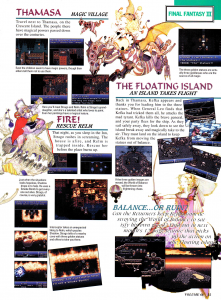
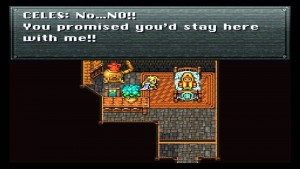
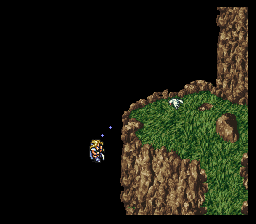
Comments 2
Remembering that I’m really only a watcher of the old FF games, and never a player, the whole central sequence of that installment blew me away; even in SF books, I had rarely encountered anyone willing to basically blow up the world halfway through and tell the rest of the story in a post-apocalypse. (start there, yes. Go boom as a climax, yes. But not give us before and after in one story.)
I’ve encountered it a lot more since — Tobias Buckell does it — but I also note it’s still more often a thing I see in Japanese storytelling. And even when it does happen, it rarely has as visual and direct an impact. Babylon 5 had a major interplanetary war, had the galaxy almost destroyed by Shadows, then by elements from Earth itself, but left all the most central locales intact. FFIII, as we understood it then, had the characters picking through the rubble. (yes, I’m aware whole planets died in B5, but they weren’t planets we visited. Earth, Mars, Centauri Prime, Minbar, even Narn, which was extensively bombed in a war, and Babylon 5 itself all remained effectively the same physically. )
And yes, in those circumstances, a suicide attempt seems an inevitable reaction from someone, but making it your one remaining player character gives it a huge depth lacking if it were, say, a popular NPC.
Author
I like the comparison with B5. Planets go boom, but it’s only really shown to matter in terms of how it affects the main characters. None of those characters are ever at any risk of becoming direct casualties except Londo, for a few minutes, and we know he’s going to make it because we’ve known since season 1 when and how he dies and that isn’t it. We don’t even, that I recall, get a before-and-after picture of Narn; I think we only see it *after* it’s bombed out. No characters we’re actually made to care about die in these disasters. Even Na’Toth eventually turns out to be a POW, not a casualty.
In FFVI, you can lose one playable character to the disaster permanently if you’re not careful, and countless NPCs some of whom actually matter are lost. Perhaps the most poignant is the loss of all the adults in Duane and Katarin’s village, who died ensuring the safety of the children, of whom this 18-year-old couple are the oldest (and it’s the birth of their child that signals that there’s still hope and the world is, slowly, healing itself). That either all or all but one of the playable characters turn out to be alive barely detracts from the bleak tone, although the sense of relief is palpable as you slowly get the band back together and prepare to take Kefka down.
As for blowing up the world not being the end of the story, I imagine that feels more like a real possibility to someone who has grown up with the Japanese, rather than North American, cultural memory. Same reason I mentioned above in connection with the Cold War.